Abstract
We raised a rabbit antiserum that completely blocked cell-cell adhesion of aggregating Dictyostelium discoideum cells in an in vitro assay. All adhesion-blocking activity of this antiserum was adsorbed with a D. discoideum fraction containing molecules having molecular weights as high as about 10(6), even after the material had been extensively digested with Pronase. The properties of this fraction indicate that the antigenic determinants in this macromolecule are saccharide residues. Antigen-rich material is found on vegetative cells but accumulates on or around differentiating D. discoideum cells as they aggregate. The cell surface of an aggregating cell contains about 5 X 10(5) antigenic sites. Antigen is also abundant in the medium of D. discoideum cells starved in suspension, which proved the most convenient starting material for its purification. Like several other macromolecules already discovered in D. discoideum by using this immunological approach, the material identified here may play a direct or indirect role in cell-cell adhesion and merits tentative consideration as a cell-adhesion molecule.
Full text
PDF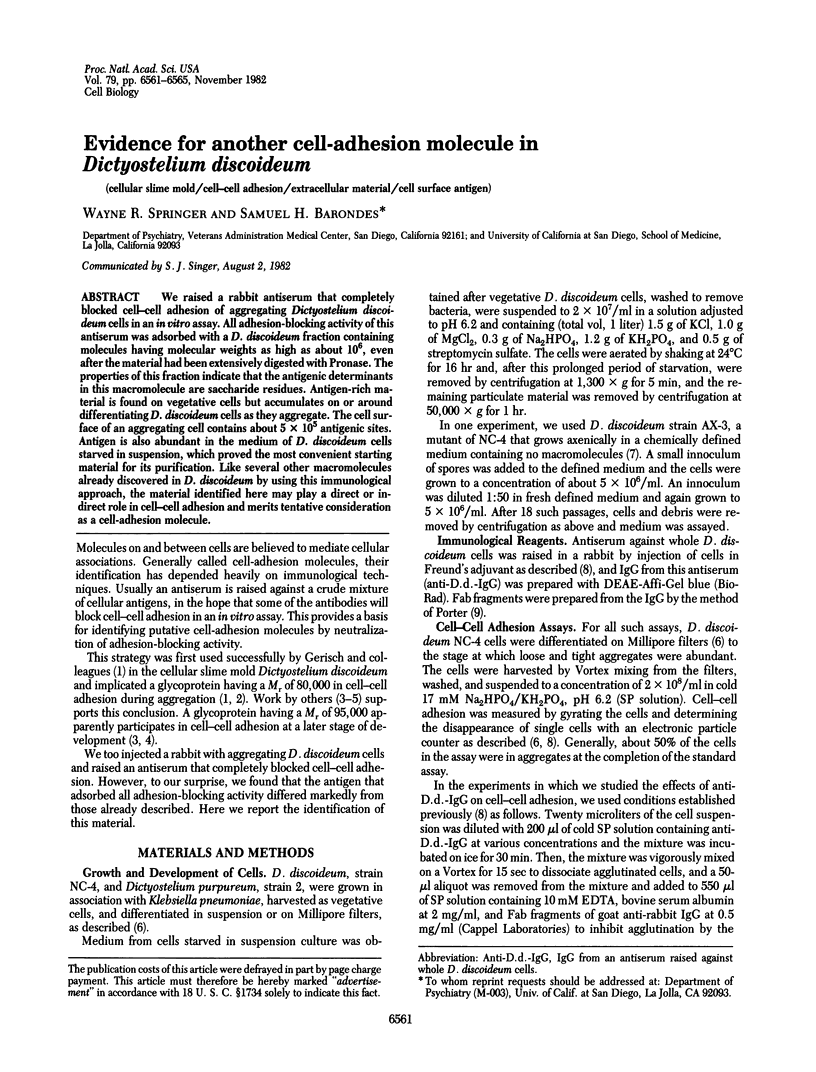
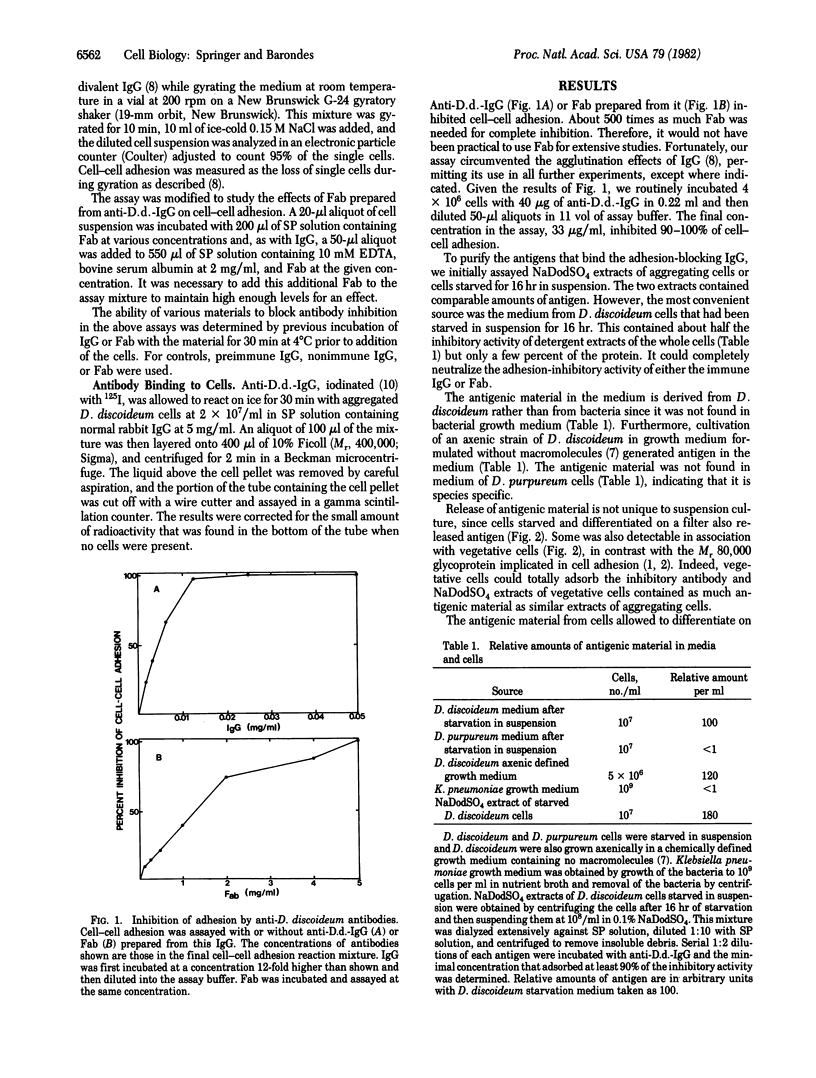
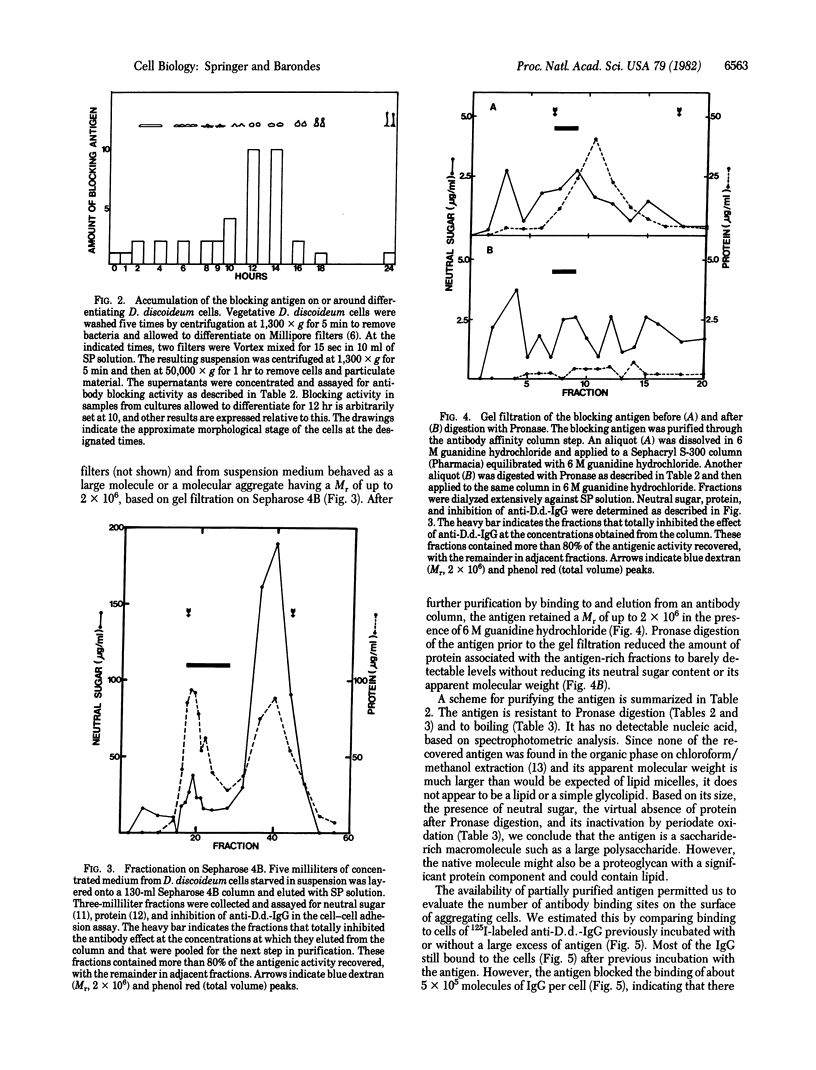
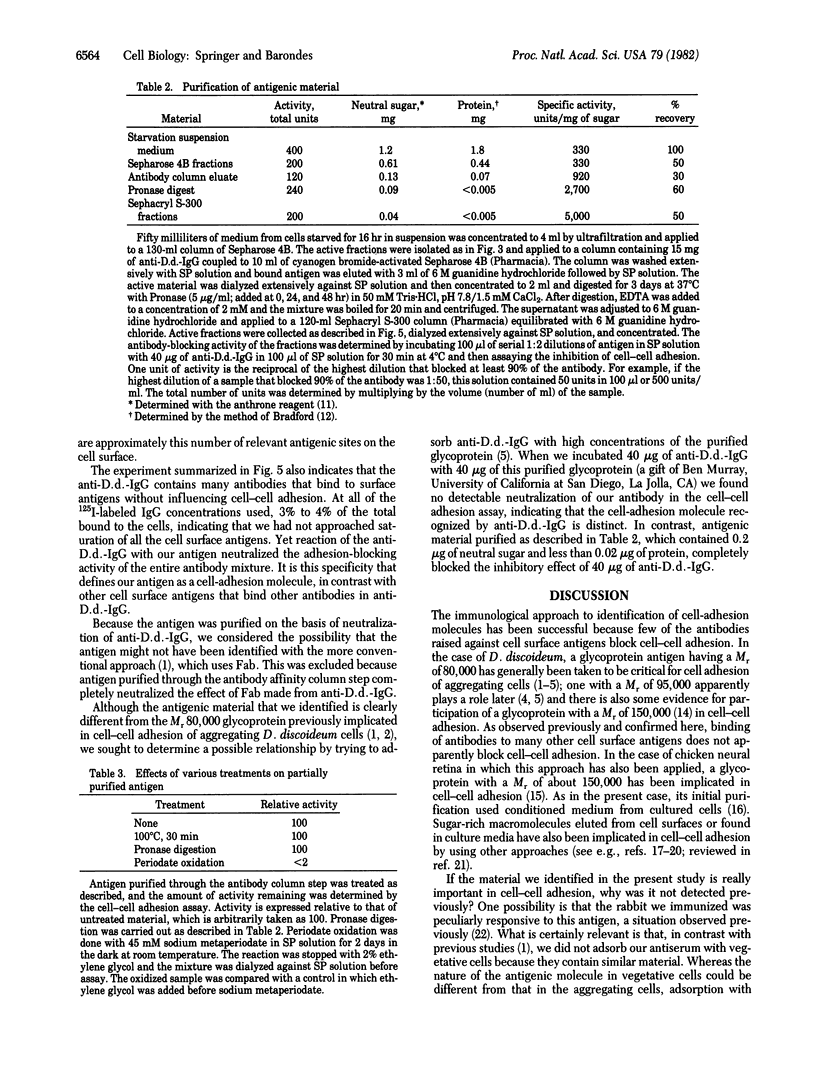
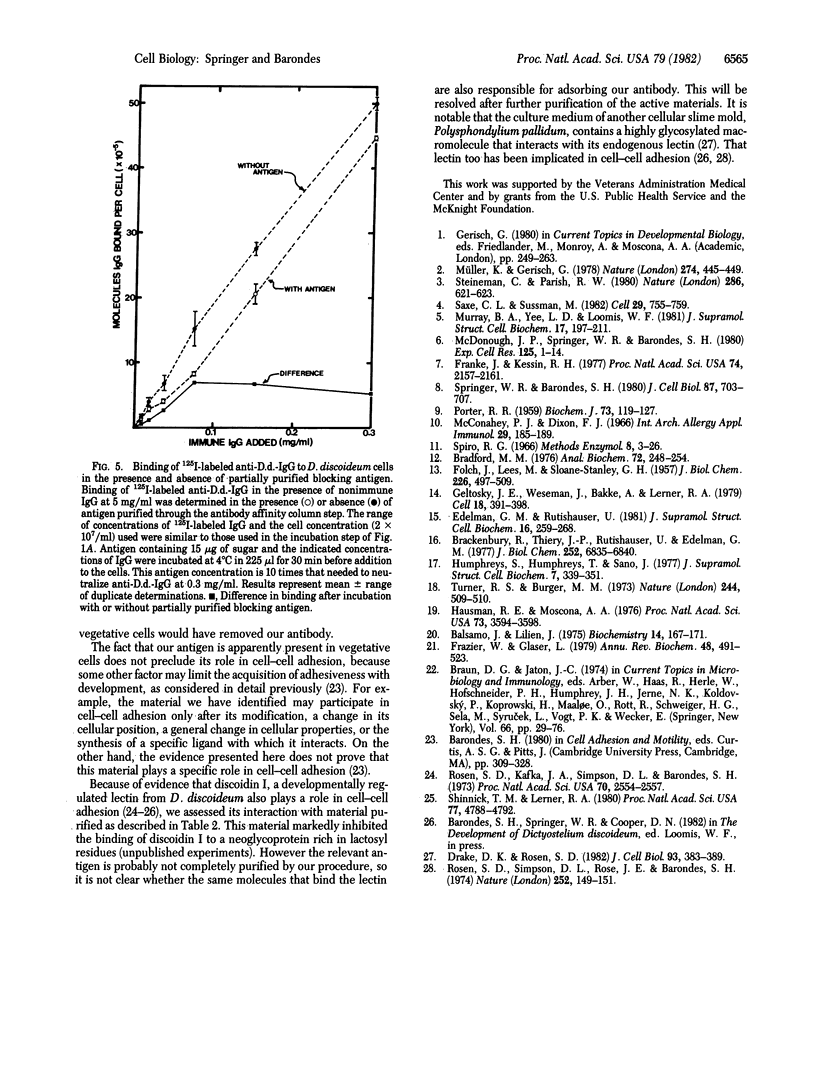
Selected References
These references are in PubMed. This may not be the complete list of references from this article.
- Balsamo J., Lilien J. The binding of tissue-specific adhesive molecules to the cell surface. A molecular basis for specificity. Biochemistry. 1975 Jan 14;14(1):167–171. doi: 10.1021/bi00672a028. [DOI] [PubMed] [Google Scholar]
- Brackenbury R., Thiery J. P., Rutishauser U., Edelman G. M. Adhesion among neural cells of the chick embryo. I. An immunological assay for molecules involved in cell-cell binding. J Biol Chem. 1977 Oct 10;252(19):6835–6840. [PubMed] [Google Scholar]
- Bradford M. M. A rapid and sensitive method for the quantitation of microgram quantities of protein utilizing the principle of protein-dye binding. Anal Biochem. 1976 May 7;72:248–254. doi: 10.1016/0003-2697(76)90527-3. [DOI] [PubMed] [Google Scholar]
- Drake D. K., Rosen S. D. Identification and purification of an endogenous receptor for the lectin pallidin from Polysphondylium pallidum. J Cell Biol. 1982 May;93(2):383–389. doi: 10.1083/jcb.93.2.383. [DOI] [PMC free article] [PubMed] [Google Scholar]
- Edelman G. M., Rutishauser U. Molecules involved in cell--cell adhesion during development. J Supramol Struct Cell Biochem. 1981;16(3):259–268. doi: 10.1002/jsscb.1981.380160306. [DOI] [PubMed] [Google Scholar]
- FOLCH J., LEES M., SLOANE STANLEY G. H. A simple method for the isolation and purification of total lipides from animal tissues. J Biol Chem. 1957 May;226(1):497–509. [PubMed] [Google Scholar]
- Franke J., Kessin R. A defined minimal medium for axenic strains of Dictyostelium discoideum. Proc Natl Acad Sci U S A. 1977 May;74(5):2157–2161. doi: 10.1073/pnas.74.5.2157. [DOI] [PMC free article] [PubMed] [Google Scholar]
- Frazier W., Glaser L. Surface components and cell recognition. Annu Rev Biochem. 1979;48:491–523. doi: 10.1146/annurev.bi.48.070179.002423. [DOI] [PubMed] [Google Scholar]
- Geltosky J. E., Weseman J., Bakke A., Lerner R. A. Identification of a cell surface glycoprotein involved in cell aggregation in D. discoideum. Cell. 1979 Oct;18(2):391–398. doi: 10.1016/0092-8674(79)90058-8. [DOI] [PubMed] [Google Scholar]
- Hausman R. E., Moscona A. A. Isolation of retina-specific cell-aggregating factor from membranes of embryonic neural retina tissue. Proc Natl Acad Sci U S A. 1976 Oct;73(10):3594–3598. doi: 10.1073/pnas.73.10.3594. [DOI] [PMC free article] [PubMed] [Google Scholar]
- Humphreys S., Humphreys T., Sano J. Organization and polysaccharides of sponge aggregation factor. J Supramol Struct. 1977;7(3-4):339–351. doi: 10.1002/jss.400070307. [DOI] [PubMed] [Google Scholar]
- McConahey P. J., Dixon F. J. A method of trace iodination of proteins for immunologic studies. Int Arch Allergy Appl Immunol. 1966;29(2):185–189. doi: 10.1159/000229699. [DOI] [PubMed] [Google Scholar]
- McDonough J. P., Springer W. R., Barondes S. H. Species-specific cell cohesion in cellular slime molds. Demonstration by several quantitative assays and with multiple species. Exp Cell Res. 1980 Jan;125(1):1–14. doi: 10.1016/0014-4827(80)90182-2. [DOI] [PubMed] [Google Scholar]
- Murray B. A., Yee L. D., Loomis W. F. Immunological analysis of glycoprotein (contact sites A) involved in intercellular adhesion of Dictyostelium discoideum. J Supramol Struct Cell Biochem. 1981;17(3):197–211. doi: 10.1002/jsscb.380170302. [DOI] [PubMed] [Google Scholar]
- Müller K., Gerisch G. A specific glycoprotein as the target site of adhesion blocking Fab in aggregating Dictyostelium cells. Nature. 1978 Aug 3;274(5670):445–449. doi: 10.1038/274445a0. [DOI] [PubMed] [Google Scholar]
- PORTER R. R. The hydrolysis of rabbit y-globulin and antibodies with crystalline papain. Biochem J. 1959 Sep;73:119–126. doi: 10.1042/bj0730119. [DOI] [PMC free article] [PubMed] [Google Scholar]
- Rosen S. D., Kafka J. A., Simpson D. L., Barondes S. H. Developmentally regulated, carbohydrate-binding protein in Dictyostelium discoideum. Proc Natl Acad Sci U S A. 1973 Sep;70(9):2554–2557. doi: 10.1073/pnas.70.9.2554. [DOI] [PMC free article] [PubMed] [Google Scholar]
- Rosen S. D., Simpson D. L., Rose J. E., Barondes S. H. Carbohydrate-binding protein from Polysphondylium pallidum implicated in intercellular adhesion. Nature. 1974 Nov 8;252(5479):128, 149-50. doi: 10.1038/252128a0. [DOI] [PubMed] [Google Scholar]
- Saxe C. L., 3rd, Sussman M. Induction of stage-specific cell cohesion in D. discoideum by a plasma-membrane-associated moiety reactive with wheat germ agglutinin. Cell. 1982 Jul;29(3):755–759. doi: 10.1016/0092-8674(82)90437-8. [DOI] [PubMed] [Google Scholar]
- Shinnick T. M., Lerner R. A. The cbpA gene: role of the 26,000-dalton carbohydrate-binding protein in intercellular cohesion of developing Dictyostelium discoideum cells. Proc Natl Acad Sci U S A. 1980 Aug;77(8):4788–4792. doi: 10.1073/pnas.77.8.4788. [DOI] [PMC free article] [PubMed] [Google Scholar]
- Springer W. R., Barondes S. H. Cell adhesion molecules: detection with univalent second antibody. J Cell Biol. 1980 Dec;87(3 Pt 1):703–707. doi: 10.1083/jcb.87.3.703. [DOI] [PMC free article] [PubMed] [Google Scholar]
- Steinemann C., Parish R. W. Evidence that a developmentally regulated glycoprotein is target of adhesion-blocking Fab in reaggregating Dictyostelium. Nature. 1980 Aug 7;286(5773):621–623. doi: 10.1038/286621a0. [DOI] [PubMed] [Google Scholar]
- Turner R. S., Burger M. M. Involvement of a carbohydrate group in the active site for surface guided reassociation of animal cells. Nature. 1973 Aug 24;244(5417):509–510. doi: 10.1038/244509a0. [DOI] [PubMed] [Google Scholar]


